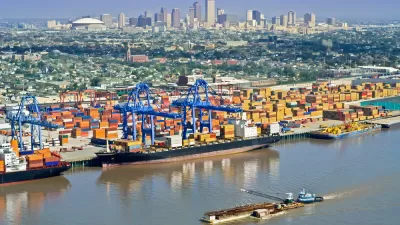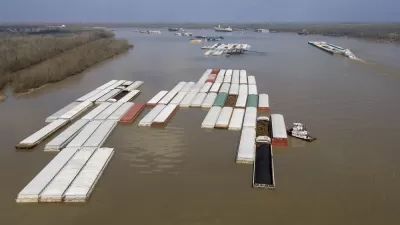The Mississippi River handles $7 billion in trade as one of the world's largest navigable inland waterways. A Midwestern drought has brought the river to water levels so low that they threaten to shut down shipping, reports John Schwartz.
"It would cripple our national economy to shut down the Mississippi River," said R.D. James, a Missouri farmer and a member of the Mississippi River Commission. Those involved in the shipping business have requested the federal government to destroy rock formations that hinder navigation in shallow water and to release water from reservoirs along the upper Missouri River. The Army Corps of Engineers has already been breaking down the formations and expect the work to be completed in 30-45 days. However, the corps has refused the second request, "saying it does not have the authority to use that water to aid navigation on the Mississippi."
Water levels have been dipping more slowly than expected, even though the Waterways Council initially warned that shipping would come to a halt by Monday. The corps estimates that water levels will dip below nine feet by January 11, and unless there is substantial rainfall or the release of water, shipping will come to a stop. "A coalition of businesses involved in trade along the Mississippi and sympathetic lawmakers have asked President Obama to order the water released," says Schwartz, "But without action from the president, Congress or the courts, the water will stay behind the reservoirs of the upper Missouri."
Carriers have been loading barges to a lighter weight to navigate the water depth, but the water crisis may force farmers to consider other transportation options. However, "[w]ith the threat of a shutdown ahead, farmers might decide to hold their grain instead of shipping it in a more expensive manner," said Gregory L. Guenther, a farmer and corporate consultant. Shifting transportation modes would be a short-term solution, but Steven L. Stockton, the director of civil works for the corps, said, "The only long-term solution is more rain."
FULL STORY: Cargo Continues Moving on the Mississippi River, but Perhaps Not for Long

Alabama: Trump Terminates Settlements for Black Communities Harmed By Raw Sewage
Trump deemed the landmark civil rights agreement “illegal DEI and environmental justice policy.”

Planetizen Federal Action Tracker
A weekly monitor of how Trump’s orders and actions are impacting planners and planning in America.

Why Should We Subsidize Public Transportation?
Many public transit agencies face financial stress due to rising costs, declining fare revenue, and declining subsidies. Transit advocates must provide a strong business case for increasing public transit funding.

Understanding Road Diets
An explainer from Momentum highlights the advantages of reducing vehicle lanes in favor of more bike, transit, and pedestrian infrastructure.

New California Law Regulates Warehouse Pollution
A new law tightens building and emissions regulations for large distribution warehouses to mitigate air pollution and traffic in surrounding communities.

Phoenix Announces Opening Date for Light Rail Extension
The South Central extension will connect South Phoenix to downtown and other major hubs starting on June 7.
Urban Design for Planners 1: Software Tools
This six-course series explores essential urban design concepts using open source software and equips planners with the tools they need to participate fully in the urban design process.
Planning for Universal Design
Learn the tools for implementing Universal Design in planning regulations.
Caltrans
Smith Gee Studio
Institute for Housing and Urban Development Studies (IHS)
City of Grandview
Harvard GSD Executive Education
Toledo-Lucas County Plan Commissions
Salt Lake City
NYU Wagner Graduate School of Public Service





























